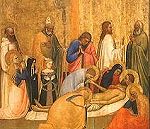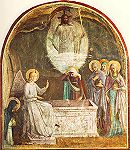
April, 2000
Themes in Art: The Passion of Christ
| By Joseph Phelan |
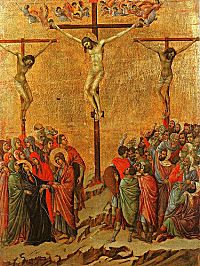 With the annual approach of the Easter Season, Christians all over the world prepare to celebrate the resurrection of Christ. The devout are often asked to reflect on the relevance of the two thousand year old legacy of Jesus Christ.
With the annual approach of the Easter Season, Christians all over the world prepare to celebrate the resurrection of Christ. The devout are often asked to reflect on the relevance of the two thousand year old legacy of Jesus Christ.One of the most salutary but overlooked aspects of this legacy is the influence which the Bible has had on Western art. For over 400 years, from the time of Giotto to Rembrandt, Western painting is inconceivable without the vision and the stories contained in the Bible, especially in the Gospels.
The Passion is given its first and genuinely comprehensive treatment in Duccio's monumental work The Maestà. In twenty six scenes he enumerates most of the significant moments of the story.
Although no other artist seems to have so ambitious as to equal Duccio's scope, the touchstone of greatness in painting has been the power to add another unforgettable image to those already realized. Thus the great rivalry between Leonardo and Michelangelo, Dürer and Grünewald, Bosch and Bruegel, Titian and Tintoretto, and Rubens and Rembrandt to capture the patronage of princes and prelates so that their vision of Christianity could dominate and endure.
The Passion as it is traditionally known (from the Latin for sufferings) is the story of the last events of Christ's earthly life. Episodes and details are drawn from the four separate accounts of Gospels. But almost all versions begin with his triumphant entry into Jerusalem a few days before Passover where he is hailed as the messiah by the people and conclude with his Crucifixion where he is mocked and despised a few days later. Events and men move with ruthless speed and an inexorable tragic necessity seems to be at work.
Jesus comes to see what he must accept in order to redeem sinful mankind: betrayal, slander, public humiliation, brutal torture, and total abandonment. Among ancient Mediterranean peoples crucifixion was considered the most shameful means of torture and execution reserved only for the worst criminals. By accepting it, Christ shows the greatest degree of self-sacrifice.
As Christianity came to dominate the West, the once shameful image of the crucifixion became the central and distinguishing symbol for the new religion. While other religions celebrated the invulnerability and power of their gods, the Church focused on the human vulnerability and suffering of Jesus, the sheer fragility of skin and bones under the lash and nail of power. Alone among world religions, Christianity defiantly displayed the wasted and twisted dead body of God in its most sacred places.
Inevitably the Church made use of art to bring scenes from the Passion to the many who could not read. When the taste for imaginative representations from the Bible became an appetite, the Church found it had at its command one of the most powerful means of reaching the deepest emotions of its members.
Let us briefly sketch the major moments of the Passion, highlighting the major works of the Western art it has called forth:
Christ prepares for his death by riding a donkey into the city of Jerusalem. Despite this humble entry, the people who have heard of his miracles go wild with excitement and greet him as the Messiah. See especially Duccio.
To show his humility Christ surprises his disciples by washing their feet before they eat. See especially Tintoretto.
|
Two moments in the meal are most often depicted: his revelation that one of the disciples who he does not name will betray him; and the Communion of the Disciples. See especially Leonardo, Tintoretto, Dali. |
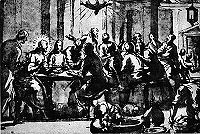 Tintoretto ink drawing with wash |
Usually showing Christ and three sleeping disciples. Knowing of his coming betrayal by Judas, Christ went with his disciples to the Garden of Gethsemane. There he took the disciples Peter, James, and John aside and asked them to keep watch while he went apart and prayed. Twice Christ returned, found them sleeping and woke them. Upon returning the third time, he said: "Sleep on now, and take your rest: behold, the hour is at hand, and the Son of Man is betrayed into the hands of sinners" (Matthew 26:45) See especially paintings by Mantegna, Bellini, El Greco.
As Christ and his disciples leave the garden of Gethsemane, a multitude armed with swords and staves appears to seize him. Judas identifies Jesus by kissing him:" Whomsoever I shall kiss, that same is he: take him, and lead him away safely." (Mark 14:44) See especially Giotto, Caravaggio.
Caiaphas the high priest presided over the Sanhedrin the high court of the of the Jewish authorities where Jesus was tried for blasphemy.
Christ tells Peter that before the night is over he will deny him not once, but three times. When all the disciples flee after Christ is arrested, Peter follows at a distance trying to keep hidden. He is discovered by a servant outside the Sanhedrin who identifies him as a follower of Christ. Peter denies Christ three times at which point a cock cries and Peter breaks into tears for his betrayal. See especially Rembrandt.
As procurator of Judea, the Roman Governor, Pilate has the final decision as to whether Christ will be condemned to death. He tries to evade his responsibility but finally bows to the pressure to condemn Christ.
Pontius Pilate orders Christ tied to a pillar, stripped and beaten by two soldiers. See especially El Greco.
|
Pontius Pilate presents Christ crowned with thorns, forced to hold a reed scepter in his bound hands-a pitiful figure faced by a bloodthirsty mob. Pilate pronounces "Ecce homo" ("Behold the man"). See especially Titian, Rubens, Rembrandt, Dürer, Bosch, Correggio, Daumier. |
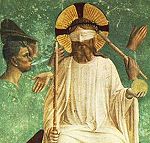 Fra Angelico |
The portrayal of Christ bearing his cross to Calvary traditionally shows the exhausted Christ falling to Earth, supporting himself with one hand. Simon of Cyrene may be seen standing before Christ, portrayed as gray-haired, bearded and wearing a short tunic. Christ bears the Cross on his shoulders, with soldiers on foot and on horseback around him. Behind Christ are shown the Virgin Mary, St. John, and a number of weeping women. Veronica may be included holding a veil. According to Matthew, as well as Mark and Luke, Simon of Cyrene was compelled to bear the cross. On the other hand, John says that Christ carried the cross. Most portrayals of the scene follow John's version. See especially El Greco.
Starting from the four gospel accounts, which differ in detail, artists have inserted many symbolic elements. After Christ was brought to Calvary, he was stripped of his clothes and crucified between crosses on which two thieves were also put to death. A sign was attached to his cross that read" "Jesus of Nazareth King of the Jews". In art, the sign reads "I.N.R.I" representing the initial letters of the four Latin words Jesus Nazarenus Rex Judaeorum. See especially El Greco.
|
Christ's body is taken down from the cross. Joseph of Arimathea, a wealthy and respected man who was secretly a follower of Christ, obtains permission from Pilate to bury the body. Traditional representations in art show a ladder against the cross, with Joseph of Arimathea mounted on the ladder and lowering the body. The Virgin Mary receives the body and kisses the face. Mary Magdalene kisses the left hand, and John kisses the right. Nicodemus extracts the nails from the feet. See especially van der Weyden, Rembrandt, Rubens. |
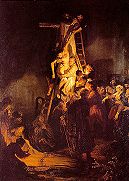 Rembrandt |
The title given to the representation of the Virgin Mary, Mary Magdalene and St. John lamenting over the dead Christ after the Deposition and before the Entombment. See especially Bellini.
Artworks with this title are similar to Lamentation and related to Deposition. Joseph of Arimathea and Nicodemus prepare to place Christ's body within the tomb. Virgin Mary may clasp the body, and John may bend over to support the feet of Christ. Accompanying women bearing myrrh weep. See especially Titian.
The events of Christ's Passion are followed three days later by the Resurrection. Very briefly, here the the key incidents in the story of the Resurrection:
After discovering the empty tomb, not knowing what has become of Christ's body, Mary Magdalene weeps. Jesus then comes to her, but she does not recognize him at first, taking him to be a gardener. When she realizes it is Jesus Christ, he tells her "Touch me not, for I am not yet ascended to my Father." - John 20:17
Christ appeared to two disciples travelling to Emmaus, but they didn't recognize him at first either. Later, when they ate together, "he took bread, and blessed it, and brake, and gave to them. And their eyes were opened, and they knew him; and he vanished out of their sight." - Luke 24:30-31
|
"Except I shall see in his hands the print of the nails, and put my finger into the print of the nails, and thrust my hand into his side, I will not believe." - John 20:25 |
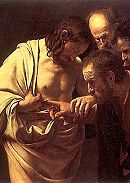 Caravaggio |
"And he led them out as far as to Bethany, and he lifted up his hands, and blessed them. And it came to pass, while he blessed them, he was parted from them, and carried up into heaven." - Luke 24:50-51
A philosophy teacher once remarked that all the books of theology ever written had less impact on the fate of mankind than the great religious paintings. After spending many hours looking at these images I think I know what he meant.
Click here for a list of Internet links to great artworks depicting the Passion.
Joseph Phelan can be contacted at joe.phelan@verizon.net
Thanks to Christus Rex for permission to reproduce some of the above images.
